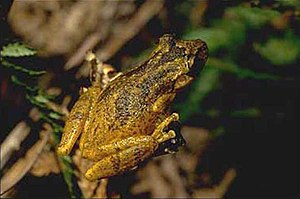Scinax perereca
| Scinax perereca | ||||||||||||
|---|---|---|---|---|---|---|---|---|---|---|---|---|

Scinax perereca |
||||||||||||
| Systematics | ||||||||||||
|
||||||||||||
| Scientific name | ||||||||||||
| Scinax perereca | ||||||||||||
| Pombal , Haddad & Kasahara , 1995 |
The neotropical articulated toes tree frog Scinax perereca belongs to the subfamily of scinax (Scinaxinae) within the family of tree frogs . Within the genus belongs Scinax perereca to Scinax rubra - clade . "Perereca" is a general term for tree frogs in Tupí . According to Faivovich et al. (2005) the species belongs to the Scinax ruber clade within the genus Scinax .
distribution
The species is so far only found in a few locations from 0 to 1000 m above sea level. NN known from the two Brazilian states of São Paulo and Rio Grande do Sul , the Argentine province of Misiones and southeastern Paraguay , where it occurs locally in Brazil and Argentina, but is rare in Paraguay.
description
This knee-toe tree frog is of medium size compared to others (males with a head-to-trunk length of 34 to 38.5 mm). The head is longer than it is wide. The muzzle appears almost round in profile and pointed when viewed dorsally. The canthus rostralis is straight. The iris is copper-colored, the back brown with dark brown spots, the neck and belly white, the inside of the thighs yellow on a black base color (so-called "flash colors"). There are also white spots on the top and bottom of the limbs and three oblique dark brown stripes on the tibia . The easiest way to distinguish the species from similar representatives of the genus is by its head-trunk length and its mating call.
Habitat and Ecology
The species is found in forests as well as on the edge of the forest, including secondary forests . It reproduces itself in temporary and permanent bodies of water and also uses artificial bodies of water and even wagon tracks filled with water.
Danger
The IUCN lists Scinax perereca as " Least Concern ". Its wide distribution and the fact that the species can adapt relatively well to anthropogenic changes, adopts a broad spectrum of habitats and the total population is estimated to be sufficiently large, explain this. The processors consider it unlikely that stocks of the species can decline quickly enough to justify a higher endangerment level. It is also found in several protected areas. The main threat to the species is the clearing of forests and the creation of pinus monocultures.
literature
- L. Aquino, A. Kwet, MV Segalla, V. Verdade, J. Faivovich, D. Baldo: Scinax perereca. (2004). In: IUCN: IUCN Red List of Threatened Species . Version 2010.1. IUCN Red List of Threatened Species . Downloaded on June 25, 2010.
- J. Faivovich, CFB Haddad, PCA Garcia, DR Frost, JA Campbell, WC Wheeler: Systematic review of the frog family Hylidae, with special reference to Hylinae: Phylogenetic analysis and taxonomic revision. (= Bulletin of the American Museum of Natural History. 294). 240 pp 2005.
- DR Frost: Amphibian Species of the World: an Online Reference . Version 5.3, February 12, 2009. Electronic Database accessible at Amphibian Species of the World . American Museum of Natural History, New York, USA.
- JP Pombal, Jr., CFB Haddad, S. Kasahara: A new species of Scinax (Anura: Hylidae) from southeastern Brazil, with comments on the genus. In: Herpetologica. Volume 29, No. 1, 1995, pp. 1-6.
Web link
- Scinax perereca inthe IUCN 2013 Red List of Threatened Species . Posted by: Lucy Aquino, Axel Kwet, Magno Vicente Segalla, Vanessa Verdade, Julian Faivovich, Diego Baldo, 2004. Retrieved October 4, 2013.